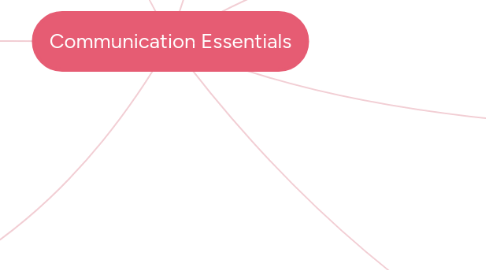
1. Culture influence on communication
1.1. The closer two individuals share a common culture, the greater the likelihood that distortions
1.2. the most things that have the greatest influence on cross-cultural communication are:
1.2.1. Race
1.2.2. gender
1.2.3. age
1.2.4. Nationality
2. Model of communication
2.1. Understanding the dynamics of communication is essential for developing good counseling skills.
2.2. Speaker statements can be interpreted in several ways
2.2.1. 1- The talker may not communicate clearly because of faulty encoding process
2.2.2. 2- Distortions also occur when words are not heard properly
2.2.3. 3- a listener can distort a message during the decoding process
3. Guidelines for enhancing counseling communication effectiveness
3.1. use focuses and intents when formulating responses
3.1.1. To acknowledge
3.1.2. To explore
3.1.3. To challenge
3.2. Use effective Nonverbal behavior
3.2.1. Body language
3.2.2. Tone of voices
3.3. Harmonize verbal and nonverbal behaviors
3.4. Analyze nonverbal behavior of your client
3.5. Communication roadblocks
4. Nutrition counseling goals
4.1. Facilitate lifestyle awareness
4.2. Healthy lifestyle decision making
4.3. take appropriate action
5. Stages of skill development
5.1. Motivation
5.2. Learning
5.3. awkwardness
5.4. Conscious awareness
5.5. Automatic response
5.6. Proficiency
6. Empathy
6.1. True understanding of another unique perspective and experience without judging, criticizing, or blaming
7. Basic counseling responses
7.1. Attending
7.1.1. you have to listening and observe the client by four things
7.1.1.1. Eye contact
7.1.1.2. Attentive body language
7.1.1.3. vocal style
7.1.1.4. , Verbal following
7.2. Reflection
7.2.1. There are five major feeling categories
7.2.1.1. anger
7.2.1.2. sadness
7.2.1.3. fear
7.2.1.4. conflict
7.2.1.5. happiness
7.2.2. you have to focus for of these with your client.
7.3. Legitimation
7.3.1. : the acceptance and validation of the clients emotional experience.
7.4. Respect
7.4.1. you have to respect your clients and their coping abilities is implied by attentive listening and nonverbal behavior
7.5. Personal support
7.5.1. You should make clear to your clients that strategies for solving their problems are available.
7.6. Partnership
7.6.1. This means that the client and counselor respect each other and work together to find solutions
7.7. Mirroring
7.7.1. : it is mean repeat back to a client exactly what was said or with few word change.
7.8. Paraphrasing
7.8.1. are rephrasing the content of what the client said and meant.
7.9. Giving feedback
7.9.1. It is telling client what you have directly observed about their verbal and nonverbal behavior.
7.10. Questioning
7.10.1. are effective responses for
7.10.1.1. gathering information
7.10.1.2. encouraging exploration
7.10.1.3. changing the focus of discussion
7.11. Clarifying
7.11.1. responses encourage clients to continue talking about their concerns in order to be clear about their feeling and experiences.
7.12. Noting a discrepancy
7.12.1. Individuals often experience a great deal of resistance to making lifestyle changes and giving up comfortable behavior pattern.
7.13. Directing
7.13.1. The directing response is telling a client exactly what needs to be done.
7.14. Advice
7.14.1. To be effective, advice should
7.14.1.1. Be given in a nonjudgmental manner
7.14.1.2. Identify the problem
7.14.1.3. Explain the need to change
7.14.1.4. , Advocate an explicit plan of action
7.14.1.5. End with an open-end question to elicit a response from the client
7.15. Allowing silence
7.15.1. At times in counseling interaction, silence is a valuable tool.
7.16. Self-referent
7.16.1. The benefit of self-referent response include
7.16.1.1. increasing openness
7.16.1.2. building trust
7.16.1.3. providing a model to increase client level of self-disclosure
7.16.1.4. developing new perspectives
7.16.1.5. creating a more impersonal atmosphere

